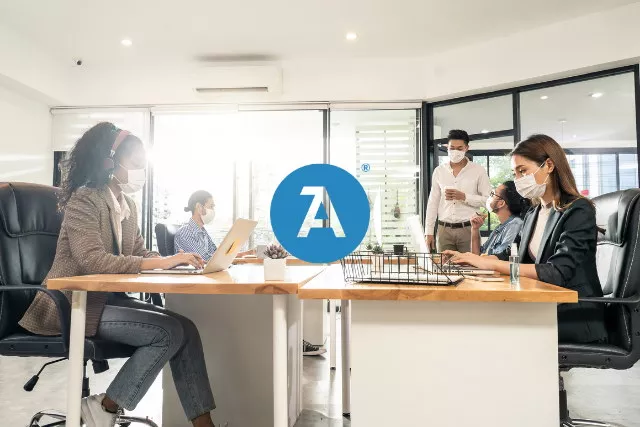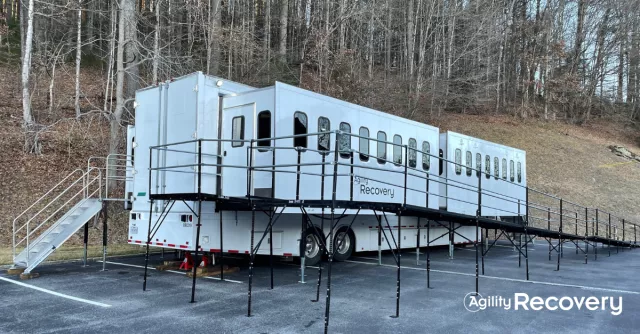How To Safely Return Your Workforce to the Office [Includes Checklist]

In March of 2020, the workforce seemed to move from offices to homes overnight. More than one year later, organizations worldwide are exploring how to return their workforces to the office as COVID-19 vaccines provide more safety and assurance. Unlike the impact and the duration of a natural disaster or a network outage, a global viral outbreak does not have a definitive timeline that indicates it's safe for businesses to start resuming normal operations, but given experiences over the past year, there are ways to return to the office safely.
To adapt to the changes and the new normal, businesses must adjust to bring successful results. Your organization, too, must consider what post-pandemic planning it can do to give employees a safe office to return to.
Recent Insights
According to PricewaterhouseCoopers, 75% of executives anticipate at least half of the workforce will be back on-site by July 2021, and experts predict herd immunity may be reached as early as Q3 of 2021.
To aid organizations in transitioning to the new normal, the Occupational Health and Safety Administration (OSHA) has published a robust guide for reopening offices more safely. Suggestions to mitigate the threat of COVID-19 in offices include conducting a hazard assessment, implementing physical distancing, and improving ventilation.
We believe that such steps as bringing employees back to work in stages, maintaining restrictions on travel, and encouraging social distancing, along with maintaining robust communication in your department and instituting contract tracing, are crucial to a successful return-to-office program.
Review Your Office Space
Before anyone can return to work in your office, you should evaluate the space. Consider how many private offices you have where employees can shut the door for privacy and safety.
If you have an open office, measure the overall space from wall to wall. Then, measure the size of a desk, and see how many can fit in the room with six feet in between. Add the number of desks and private offices to figure out how many people can work in your office safely. That number can help you start your post-pandemic planning for your office.
Alternatively, you can leave every other desk open. While that means fewer people can return to work, it can keep those who return even safer. You can also consider improving your office ventilation system and even adding barriers between workspaces.
Determine Roles to Return
Look at your workforce and make a priority list of roles to bring back and when based on all relevant information driving that decision, such as business needs or budget. You should also consider who can or should keep working remotely some or all the time. That way, you can optimize the number of employees who do return to the office.
Finally, find out if you have any high-risk employees. If there are such people in your company, provide them the option to work from home. You can also create a return to office plan in which employees return during different, staggered weeks. That way, you don't have a massive uptick of people returning.
Rotate Work Schedules
The next thing you can do is rotate when employees return to work in the office. If you have many people you want to be in the office, consider whether everyone needs to be there every day.
Perhaps your customer support team can rotate in-person and remote work throughout the week. You can divide people into a few groups and have them come in two or three days per week. Even one in-person day can help. If your software engineers need access to a specific computer, they can use it to do some of their work that day and focus on other tasks from home.
Possible Schedule Rotations
If you have two groups of employees who wish to return to work, you can create two in-person schedules. For example, the first group can work in the office on Mondays and Wednesdays. The other group can do Tuesdays and Thursdays. Every other week, you can rotate who works in the office on Fridays or have everyone work from home on that day.
Consider how many employees you want to work in the office. Compare that to how many desks you can have safely. Then, you can come up with a schedule that works best with your office setup.
Incentivize Employees to Return to Office
After more than a year of remote work, many employees are ready to come back to the office; in fact, only one in five workers reported wanting to continue working from home all the time.
Even so, there may be some reluctance on the part of employees to return fully to the office. Be prepared to offer flexibility and clarity around when employees need to be in the office versus only need to be in on an optional basis.
Use a Return-to-Office Checklist
Now it's time to set some return-to-office guidelines. The Agility Recovery team has developed a short yet comprehensive Return-to-Office Checklist your business can follow.
Using a defined checklist will help everyone be aware of what they need to do before their first day back to follow the rules and stay safe. To give your organizations more flexibility and various options, below are a few different checklists you can create for multiple steps regarding working in person.
Pre-Entrance Steps and Entrance Checklist
Consider if you want employees to follow particular steps before they reach the office. You can have employees get tested for COVID and wait for negative results, particularly before their first time back in the office.
For daily returns after the first time back, you can have employees use a COVID tracking app. You can ask them to use the same app and submit their results before they show up to work.
Then, if someone does have a high risk of having COVID, you can ask them to stay home. You can also have employees answer a short checklist regarding their symptoms and go from there.
When employees do get to the office, you can follow another checklist. You can have someone sit by the door and take employee temperatures as they come in.
You should also have someone make sure employees wear a mask when entering the office and ensure people are wearing face coverings correctly.
In the Office
You can also create a checklist for how employees can work safely during the day. If employees have a private office, you can allow them to remove their masks.
Employers should still encourage employees to wear masks whenever they’re not in a private enclosed space to help mitigate the spread of COVID-19. Your checklist for the workday can include these steps, and you can give a copy to each employee. Put the list around common work areas in case people lose the checklist.
Communicate New Guidelines
Once you make a few checklists, you should send those guidelines to your employees. Give everyone a new visual map of the office so that they can see where everyone will be. You can also include specific actions employees can take to stay safe. In addition to written guidelines, you can also use posters and photos to reinforce the steps. And if your city makes any changes to their recommendations, you should update your staff.
Post Signs Around the Office
Consider posting signs throughout the office. You can use photos of how to wear a mask so that it keeps people safe. Consider making one poster a list of potential COVID symptoms.
You can also post signs in the office bathrooms on how to wash hands thoroughly. Make the posters colorful and easy to see from far away. Posters and visuals may seem overboard, but the more your employees see them, the more they will understand how everyone can return to work safely.
Guideline Changes
If you need to change your guidelines, you should inform your employees as soon as possible. Let your team know when the changes will take effect and give people a chance to adapt.
The most efficient way to do so is through an emergency notification platform. These tools allow you to reach out to your entire workforce at the same time, no matter their geographical location, device, or department. What makes this platform a tool for communication is that it gives your people an option to reply, letting you know they are safe. There are other software features that can provide a lifeline during an emergency, including preloaded message templates and a knowledge base.
Whether the changes involve bringing more people back to the office or sending employees home, make the rules clear. Give employees a copy of the guidelines, and let people ask questions. These materials can also be accessed through a central platform.
Make sure to also stay up to date with your state’s guidelines around paid sick leave. These guidelines differ by state and may change quickly.
Stock the Office with Supplies
As people start returning to the office, you should consider how to keep your office clean. While you may have a cleaning crew that works in the evenings, employees should also have access to supplies. Whenever someone needs to use a different desk, they should clean it to get rid of any germs. That way, whoever uses it next can do so safely.
Here are some examples of supplies you may want in your office.
Cleaning Supplies
You can have sets of cleaning wipes throughout your office in common areas. Place some wipes near the copier, coffee machine, and in the break room. Consider putting them near employee desks, especially if you rotate work schedules. Then, employees can clean their work surfaces before and after they work. Ask employees to monitor the stock of cleaning supplies so that you can order more when your office is running low.
Face Coverings and Other PPE
You may also want to offer face coverings on hand for when employees forget to wear a mask. Set a box of masks near the entrance so that people don't have to walk through the office to get them.
Depending on your type of work, you may want other equipment. If employees work with their hands, you may want to give them gloves. You may also want to provide individual pop filters for your customer service team. That way, they can share a headset without having to worry about transferring germs.
Follow Local Officials
You can do as much planning as you want, but you should always follow local health officials. If they recommend companies go back to full remote work, you should do that if possible. And if officials say it's okay for more people to return to work, you can follow that. But be flexible with your plans so that you can follow expert recommendations.
Consider reopening phases and where your city may be in the process. Keep an eye on COVID trends to prepare for any change in local recommendations.
Watch Case Numbers and Trends
While many people are getting vaccinated, some of your workforce, visitors and vendors may choose not to. It is still important to monitor COVID-related news in your area. Keep up with the news at least once a week and watch for significant changes. A quick Google search can show you some basic statistics on COVID in your city. You can also follow local news outlets for more information.
Be Prepared to Return to Remote Work
If there was a confirmed case and exposure in the office or if your city implements further restrictions, be ready to promptly notify employees with instructions for remote work. Be sure everyone can continue to do their job to some degree from home.
Know How to Return to the Office Safely
No matter your industry, you and your employees are probably ready to return to work in your office. However, you should have a detailed plan to keep everyone safe. You may need to take extra time, but that will be worth making employees more comfortable when they come back.
Does your office need help with post-pandemic planning and health safety management? Reach out, and one of our experts will help your organization with personalized business continuity planning, alerting, training and more to ensure a safe and efficient return to the workplace.



